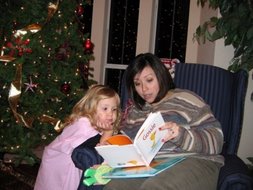Introduction: The National Council of Teachers of English (NCTE) attempts to connect educators and children to poetry by supporting its publication and encouraging its use. Every three years they honor a poet for their contributions to children's poetry. Mary Ann Hoberman is the Award Winner for 2003. Her poem, Frog, is a fun read aloud because of all the descriptive and nonsense words used in the poem. It's the perfect accompaniment to a biology lesson on amphibians. Try reciting it fast first to imitate the quick movements of frogs. Reading it rapidly also accentuates the humor of the words. Then recite it a second time much more slowly so that students can comprehend the imagery.
Frog
by Mary Ann Hoberman
Pollywiggle
Pollywog
Tadpole
Bullfrog
Leaps on
Long legs
Jug-o-rum
Jelly eggs
Sticky tongue
Trick flies
Spied by
Flicker eyes
Wet skin
Cold blood
Squats in
Mucky mud
Leaps on
Long legs
Jug-o-rum
Jelly eggs
Laid in
Wet bog…
Pollywiggle
Pollywog.
Hoberman, Mary Ann. Betty Fraser, illus. 1998. The llama who had no pajama. San Diego: Browndeer Press.
Extension: For younger children, this poem can easily lead into a simple craft where strips of long green paper are accordion folded to become the legs on the frog. Cut out simple frog bodies that students can color or draw on. Then tape or glue the frog legs on to the body. Once everyone is finished, repeat the poem while the children make their frogs jump.
Challenge older children to write a poem about their favorite animal starting and ending in the same way, like this poem. Ask that they keep each line to only one or two words. Encourage them to experiment with fun word pairings or to make up words of their own. Have them illustrate their work and create a display for your library or classroom.
Subscribe to:
Post Comments (Atom)

No comments:
Post a Comment